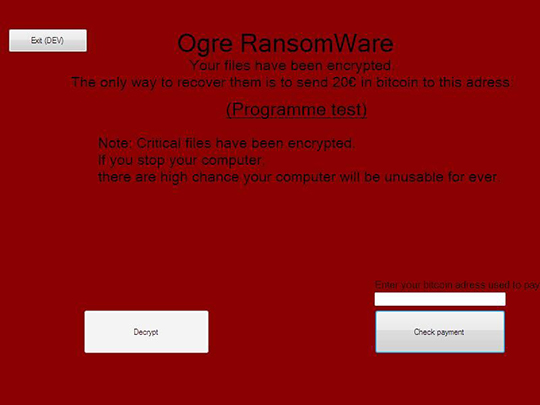RANSOM_OGRE.A
Trojan-Ransom.Win32.Fairy.a (Kaspersky); Generic.Ransom.Ogre.FCECE66A (Bitdefender); Trojan:Win32/Skeeyah.A!bit (Microsoft)
Windows


Threat Type: Ransomware
Destructiveness: No
Encrypted: No
In the wild: Yes
OVERVIEW
Dropped by other malware, Downloaded from the Internet
This Ransomware arrives on a system as a file dropped by other malware or as a file downloaded unknowingly by users when visiting malicious sites.
It encrypts files found in specific folders.
TECHNICAL DETAILS
394,240 bytes
EXE
No
05 Jun 2017
Terminates processes, Connects to URLs/IPs, Displays windows, Encrypts files
Arrival Details
This Ransomware arrives on a system as a file dropped by other malware or as a file downloaded unknowingly by users when visiting malicious sites.
Autostart Technique
This Ransomware adds the following registry entries to enable its automatic execution at every system startup:
HKEY_CURRENT_USER\Software\Microsoft\
Windows\CurrentVersion\Run
OgreRSMWRE = “{Malware Path and File Name}”
Process Termination
This Ransomware terminates the following processes if found running in the affected system's memory:
- taskmgr
- explorer
- iexplore
- MicrosoftEdge
- Steam
- SteamService
- steamwebhelper
- msconfig
- quickassist
- seccenter
- bdagent
- vsserv
- vsservp
- ProductAgentService
Other Details
This Ransomware does the following:
- It connects to the following URL(s) to download its encryption key:
- http://ogrersmwre.{BLOCKED}b.com/enckey1
- It connects to the following URL when the (Programme Test) hyperlink is clicked:
- https://www.{BLOCKED}se.com/
- It has an uncalled function that can decrypt the files it encrypts.
It opens a window which displays the ransom note:

Ransomware Routine
This Ransomware encrypts files found in the following folders:
- A:\
- B:\
- C:\
- D:\
- E:\
- F:\
- G:\
- H:\
- I:\
- J:\
- K:\
- L:\
- M:\
- N:\
- O:\
- P:\
- Q:\
- R:\
- S:\
- T:\
- U:\
- V:\
- W:\
- X:\
- Y:\
- Z:\
- C:\Program Files (x86)\Steam\
- C:\Program Files (x86)\Steam\steamapps\common\
- C:\Windows\
- C:\Windows\System32\
It appends the following extension to the file name of the encrypted files:
- .ogre
NOTES:
The program has certain errors that prevents a few capabilities of the malware.
SOLUTION
9.850
13.454.01
05 Jun 2017
13.455.00
06 Jun 2017
Step 1
Before doing any scans, Windows XP, Windows Vista, and Windows 7 users must disable System Restore to allow full scanning of their computers.
Step 2
Note that not all files, folders, and registry keys and entries are installed on your computer during this malware's/spyware's/grayware's execution. This may be due to incomplete installation or other operating system conditions. If you do not find the same files/folders/registry information, please proceed to the next step.
Step 3
Restart in Safe Mode
Step 4
Delete this registry value
Important: Editing the Windows Registry incorrectly can lead to irreversible system malfunction. Please do this step only if you know how or you can ask assistance from your system administrator. Else, check this Microsoft article first before modifying your computer's registry.
- In HKEY_CURRENT_USER\Software\Microsoft\Windows\CurrentVersion\Run
- OgreRSMWRE = “{Malware Path and File Name}”
- OgreRSMWRE = “{Malware Path and File Name}”
Step 5
Restart in normal mode and scan your computer with your Trend Micro product for files detected as RANSOM_OGRE.A. If the detected files have already been cleaned, deleted, or quarantined by your Trend Micro product, no further step is required. You may opt to simply delete the quarantined files. Please check this Knowledge Base page for more information.
Step 6
Restore encrypted files from backup.
Did this description help? Tell us how we did.

